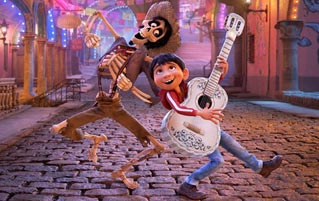Why The Afterlife In Pixar's 'Coco' Is Secretly Terrifying

There are so many positive things to say about Pixar's Coco. We don't get many Hispanic good times in animation, and the team behind the movie has tried its very best to see Mexican culture portrayed as accurately as possible in a movie that also has magical skeletons. But despite being so colorful, warm, and hopeful, Coco is also one of the most terrifying, nihilistic, and soul-crushing animated movies to have ever been slapped with a PG rating. We're speaking, of course, of its depiction of the afterlife.
Set during Dia de los Muertos, a day of remembrance when the dead can return to be with their loved ones, Coco follows the story of Miguel, a boy who loves music but whose family has banned it like they're living in a Mexican Footloose -- or Suelto de los Pies, if you will. In secret, Miguel learns to play the guitar from watching the movies of the late great balladeer Ernesto De la Cruz, a man he believes to have been his great-great-grandfather who abandoned the family to pursue his love of song. 109-minute story short, Miguel steals a guitar that belonged to De la Cruz and ends up cursed and stuck in the Land of the Dead, a place where the dead live out their afterlives and outdoor party lighting is apparently always on sale.

But for all its vibrancy and charm, there is a sinister implication to Coco's afterlife. As Miguel learns, the reason honoring the dead is such an important tradition is that it's the only thing keeping the spirits of the deceased in the afterlife. As long as someone alive still cares enough to remember them, the dead get to keep "living" in a society not so different from the one they left behind. Once they are forgotten in the living world, they just disappear. Where do they go? What becomes of them? Nobody knows. But what are the odds that there's an after-afterlife?
But there's another way of being remembered besides having a loving and dutiful family, one that's a lot more effective: being shit-hot famous. Coco doesn't shy away from showing us the effects of this fame-based caste system, either. In one scene, we see over half a dozen famed Mexican icons:

The oldest skeleton of the bunch is the mustachioed man with the sombrero on the left, Mexican revolutionary hero Emiliano Zapata, who died in 1919. That was almost a century ago, but Zapata doesn't look like he's worried about his necrotic lease running out. After all, it's all but impossible to be forgotten if you're in the history books. The movie even shows some Aztec folks wandering around, implying heavily that as long as you were famous enough to have some historical significance, you're basically immortal. But when it comes to your ordinary person who lived a century ago, how long do they have before the death clock runs out once again?

But that's not even the bad news. You know who else we'll never be forgetting? Hitler. There's clearly no Heaven or Hell system in Coco, so everybody dead winds up in the same warm, fun place as long as their names keep rattling around in people's memories. Unknown soldiers, humble farmers, leper colony doctors -- all those extras of history are already gone. But Christopher Columbus, Vlad the Impaler, and Cracked archenemy Thomas Edison? They're not going anywhere. Osama bin Laden probably just finished applying for a thousand-year loan on his upper-level villa. The movie shows as a fact that both the wicked and the righteous get the same vacation of an afterlife, and that killers can dead it up with the rest as long as they have an IMDb page and some fans left. It's more Mount Olympus than Heaven -- a place where famous heroes and villains alike are rewarded with immortality. You and your loved ones? You'll be lucky if you get to aimlessly wander around for about a century before quietly drifting into nothingness surrounded by family. Sounds depressingly familiar, doesn't it?
So upon closer inspection, the biggest gift of Coco isn't its generous dose of art, music, or culture, but the most morally questionable afterlife in animation history. It teaches kids that only fame matters, and appearing in one viral YouTube video can earn you more mileage in the afterlife than living good and decently out of the spotlight. But hey, at least the ballads are catchy, right?
If you loved this article and want more content like this, support our site with a visit to our Contribution Page. Or sign up for our Subscription Service for exclusive content, an ad-free experience, and more.
It doesn't have to be The Day of the Dead to rock some bad @$$ sugar skull decorations!
For more check out 21 Shockingly Dark Moments in Beloved Children's Movies and 9 Traumatizing Moments from Classic Kids Movies.
Subscribe to our YouTube channel and check out 4 Bizarrely Disturbing Implications of Children's Movies - Today's Topics, and watch other videos you won't see on the site!
Also follow us on Facebook. You'll love it.
And to further expand your noggin, check out Cracked's De-Textbook: The Stuff You Didn't Know About the Stuff You Thought You Knew.
It's loaded with facts about history, your body, and the world around you that your teachers didn't want you to know. And as a bonus? We've also included the kinkiest sex acts ever described in the Bible.


